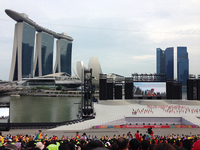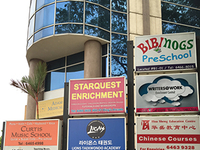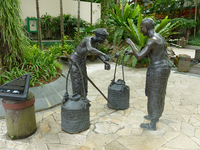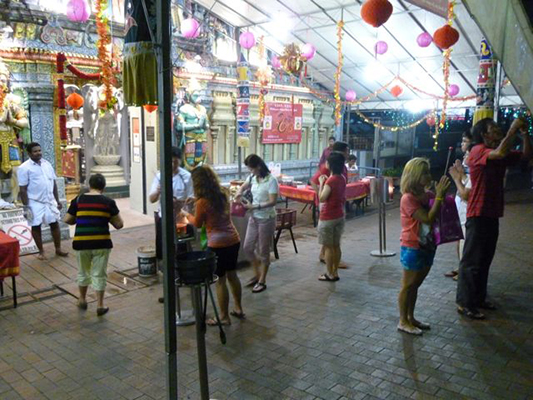Read more about Singapore Sociology

After Globalization
by Daniel P.S. Goh

After Secularism
by Francis Khek Gee Lim

After Meritocracy
by Youyenn Teo

After Multiracialism
by Noorman Abdullah
February 17, 2017
The looming figure of the late Lee Kuan Yew, the first Prime Minister of independent Singapore, appears to have defined the very existence and identity of this island nation-state. The Singapore style of governance associated with, and indeed extending from, the persona of Lee Kuan Yew, has been christened “pragmatic authoritarianism,” “soft-style authoritarianism,” “enlightened despotism” and even “benevolent dictatorship.” The state’s narrative upholds the principles of meritocracy, multiculturalism, and rule of law as having delivered clean government, efficient bureaucracy, modernization, economic development and prosperity, and one of the world’s highest per capita incomes. Invoking an ideology that accepts socio-cultural differences amongst its constituent ethnic groups and accords “equality” to all (see Noorman Abdullah’s essay, “After Multiracialism” in this issue), this narrative speaks not to numerical equivalence but to equality of opportunity, rejecting official and institutionalized-based ethnic discrimination by privileging merit. But this powerful credo has made it challenging, if not impossible, to even articulate a discourse on racial differences and racism; it has rendered invisible the politics and contradictions of a calibrated meritocracy (see Youyenn Teo’s essay, “After Meritocracy” in this issue).
Singapore’s managerial and administrative style of politics has prioritized planning, efficiency, control, and regulation. The day-to-day functioning of Singaporean society is framed by a bureaucracy viewed as devoid of corrupt and dishonest practices – and one that operates efficiently, perhaps too efficiently. Inherited from the British, this “infrastructure” has been honed and meticulously reproduced by the Singapore leadership to reinforce scrupulous adherence to rule-governed behavior – something that would both impress and disturb Max Weber. Its guiding principles of centralized governance and close engagement with all societal domains have required an expansive state machinery with a supporting network of bureaucratic organizations. It is precisely through these mediating institutions that the state aspires to enforce policies that impact everyday lives of its citizens, inevitably enacted under a canopy of pervasive authoritarian and pragmatic ideologies. Describing Singapore’s “culture of control,” Carl Trocki argued that the postcolonial state exercised greater levels of authority and “took responsibility for […] complete management and surveillance of society.” Chua Beng Huat and Kwok Kian Woon also note that in post-independence Singapore, the “expansion in state intervention and […] a concentration of power in the state machinery” have further reduced autonomy in several areas of everyday life.
Academic and lay discourses alike link Singapore intimately and inextricably with Lee Kuan Yew and his brand of uncompromising, authoritarian politics. Singapore’s citizenry have been typically described as conservative, fearful, docile, and passive. However, Singaporeans have long been critical of a top-down, “using a sledge hammer to break open a walnut” approach to governance – an integral and sometimes tiresome part of public discourse in Singapore.
And what of the relationship between political structures and social science? Singapore’s sociology has also been persistently viewed through the lens of Lee Kuan Yew. Postcolonial Singapore’s leaders prioritized economic growth – reflecting the needs of a newly-independent country where economic development and calculated social change seemed urgent. Social science research (funded largely by the government) was expected to be “relevant,” feeding into the nation-building project if not contributing directly to the modernizing process. From 1970 through the 1990s, social science knowledge production was geared towards generating information about the Singapore’s rapid sociocultural, economic, and political changes, reflecting the priorities of a nation-state managing a multi-ethnic, multi-religious population.
Recently, however, this alignment between university-based social scientists and national interests – never absolute – has become more tenuous. Singapore’s sociologists have problematized the state’s narrative on multiculturalism, meritocracy, family, neo-liberalism, globalization, Singapore’s history, multi-religiosity and religious harmony, absence of poverty and inequalities, etc. In another twist, the Singaporean state is now building independent research capacity in its various ministries, a move that could reduce reliance on university-based research.
Not surprisingly, the passing of Lee Kuan Yew in 2015 triggered visceral responses for many Singaporeans, as the nation mourned the loss of modern Singapore’s architect and rudder. But interestingly, this has also been a liberating moment of sorts, with a sense of being unbound from restrictions and hyper-regulation, and of movement towards freedoms, including political ones.
But this almost euphoric tone needs to be tempered with a good dose of sociological imagination. As an ethnographer practicing my craft in Singapore, my research on religions in practice is grounded in the primacy and efficacy of everyday life. Given the broader organization of social and political life, the island’s sacred domains are similarly embedded within a highly rationalized mentality, framed by bureaucratic, administrative, and legislative boundaries. The uniqueness of Singapore’s religious landscape, especially its culture of bureaucracy and its impact on expressions of religiosity, needs elaboration (see Francis Lim’s essay, “After Secularism” in this issue).
That the Singaporean state is interventionist has been the starting point of my work, which maps the “messiness” of Singapore’s religious landscape, revealing the world of “jungle temples” (sacred sites located in sheltered spaces to escape the authorities’ gaze), and the realm of religious festivals and places of worship – making visible the entwined everyday religious lives of lay Singaporeans as Hindus, Taoists, Buddhists, and Catholics. As religious practitioners recreate sacred geographies and consciousness in highly circumscribed terrains, the topography of urban Singapore demonstrates the “disarray” and “disorderliness” of its religious realm: religious processions have even been enacted in sports stadiums and religious festivals held in swimming pools. The “disregard” for carefully-drawn boundaries of “sacred/ secular” and “private/public” typified Singapore’s religious domain, throughout Lee Kuan Yew’s authoritarian reign. These alternative readings of the religious sphere and its engagement within the political confront dominant views of Singapore city as sanitized, sterile, and overly regulated.
What then can be said of the everyday capacity to negotiate official structures? Despite the firm presence of bureaucratic structures and an interventionist stance, a strong desire for religious experimentation defines Singapore’s religious domain. While such interventions do reconfigure the religious sphere, they do not eliminate religious innovation and creativity. Regulating religion has unintentionally opened up new spaces for religious freedom. In practice, this labyrinth of officialdom leaves room for negotiation, as practitioners make strategic use of regulations to achieve desired everyday outcomes.
My ethnography of the complex socio-political and religious landscape of Singapore, has encouraged me to query stereotypical characterizations of jaded, passive, oppressed citizens facing a highly authoritarian government, especially during Lee Kuan Yew’s tenure. My narrative is indeed at odds with the typical account of Singapore’s religious domains, and is set against the hegemonic discourse of a controlling Singapore state that has functioned to over-determine individuals’ lives, leading at best to docile, predictable behavior, and at worst, to paralysis and lack of agency.
With the lens of an authoritarian state firmly in place, academic (and lay) narratives are often defined by a bullish certainty either that the Singapore story is already well known, or that what might be revealed would be predictably dull and uninspiring. Singapore Studies in general continue to confront readings of Singapore’s sociocultural and political life mediated by a rather dated view of Singapore’s politics. Indeed, in presenting alternate visions of Singapore society, I have sometimes been read either as an apologist for an authoritarian state, or as naively content with describing “micro,” everyday victories of the subjugated citizen/non-actor, without recognizing that the macro, political apparatus remains firmly hegemonic.
Thus, Singapore’s sociology has its hands full. It has to not only produce alternative readings of official, hegemonic narratives and accounts of Singaporean society, but also to address persistently cynical interpretations of both Singapore’s society and its sociological sense-making. Moving beyond these clichéd, formulaic discourses towards plural, alternative imaginings of Singaporean social and political life needs to be embraced both as a challenge and an ambition. Social structures are not crafted by individuals; neither do they disappear overnight. The real question may well be: What of Singapore’s political landscape after current Prime Minister Lee Hsien Loong?
Vineeta Sinha, National University of Singapore, ISA Vice-President for Publications, 2014-2018 <socvs@nus.edu.sg>
This issue is not available yet in this language.
Request to be notified when the issue is available in your language.
If you prefer, you can access previous issues available in your language:

















